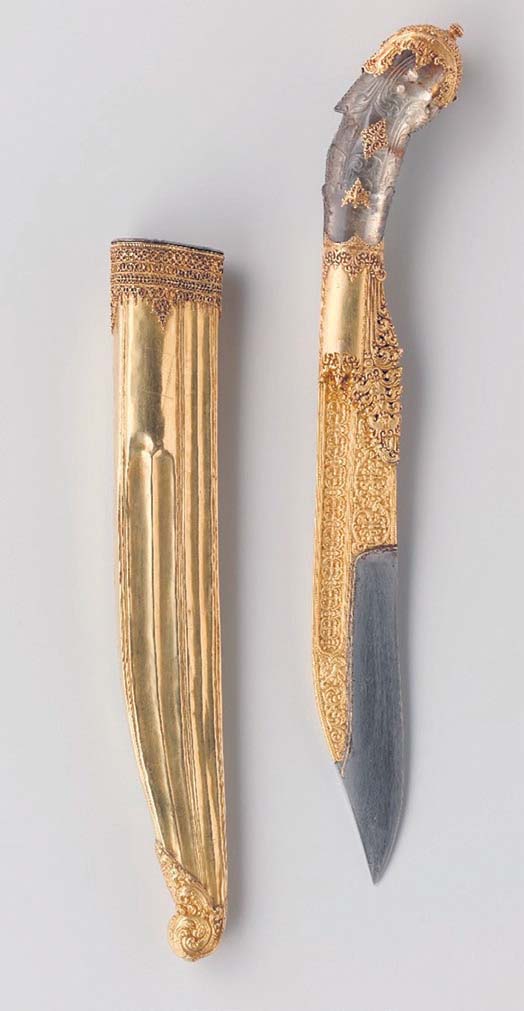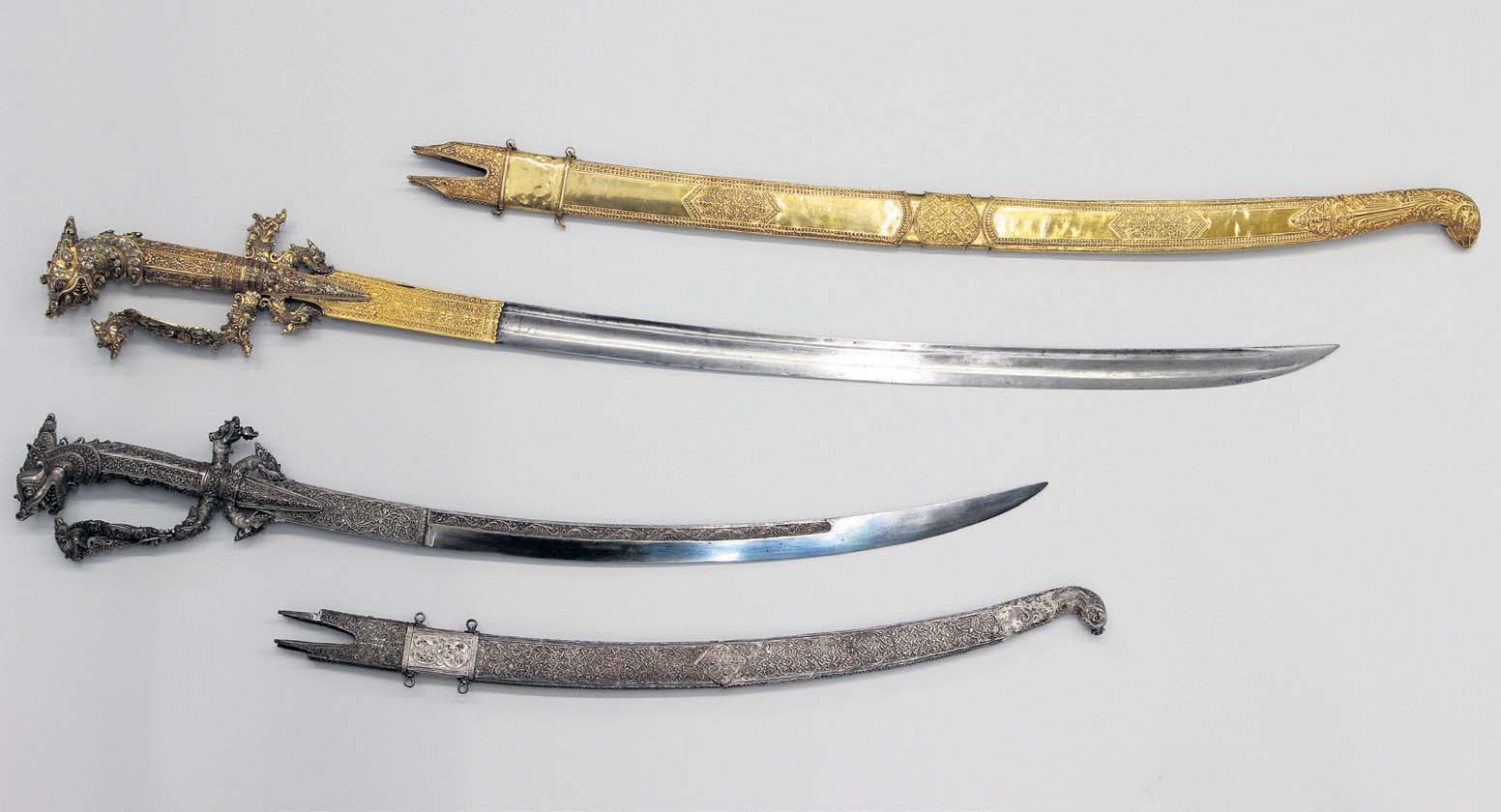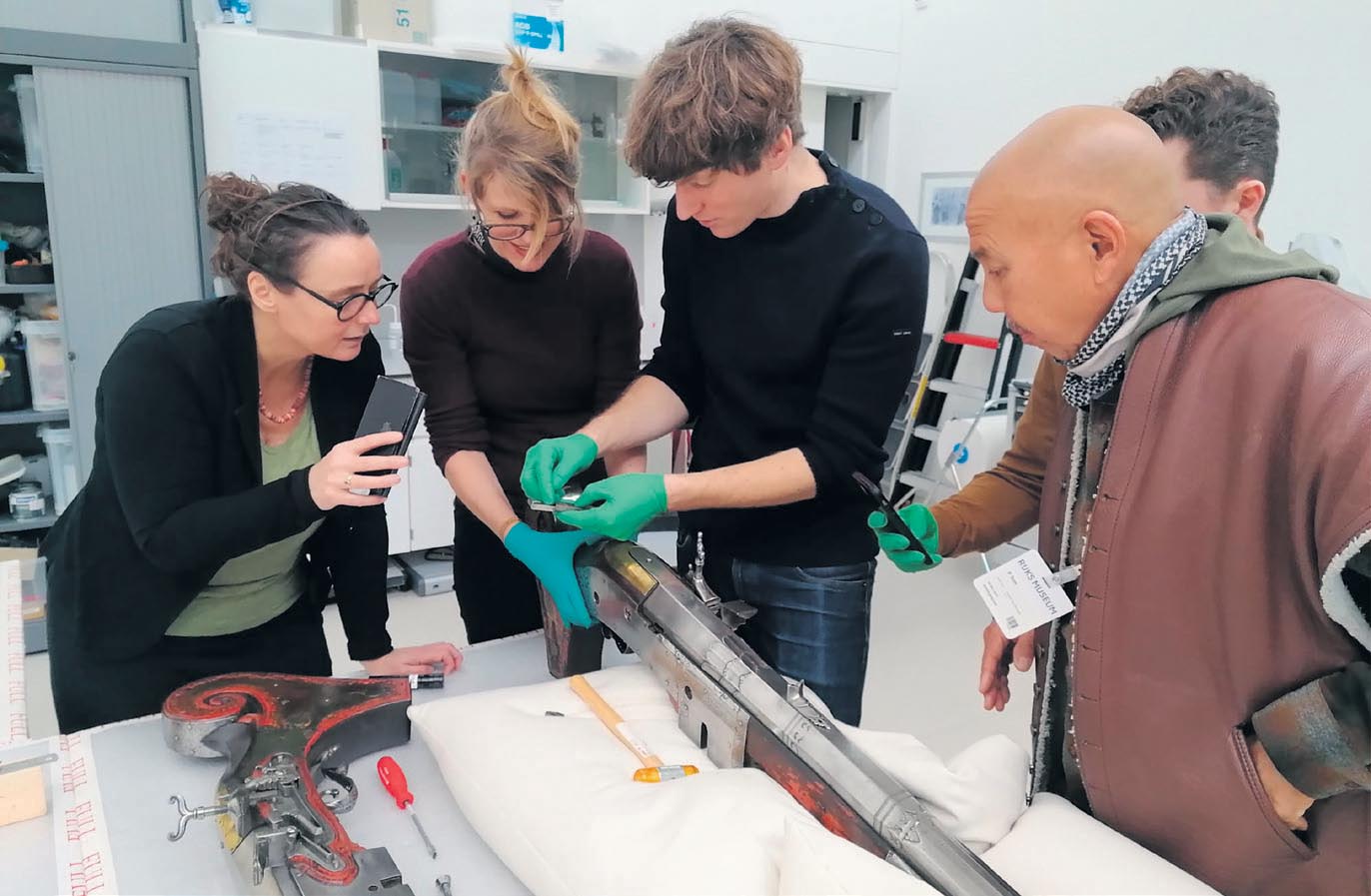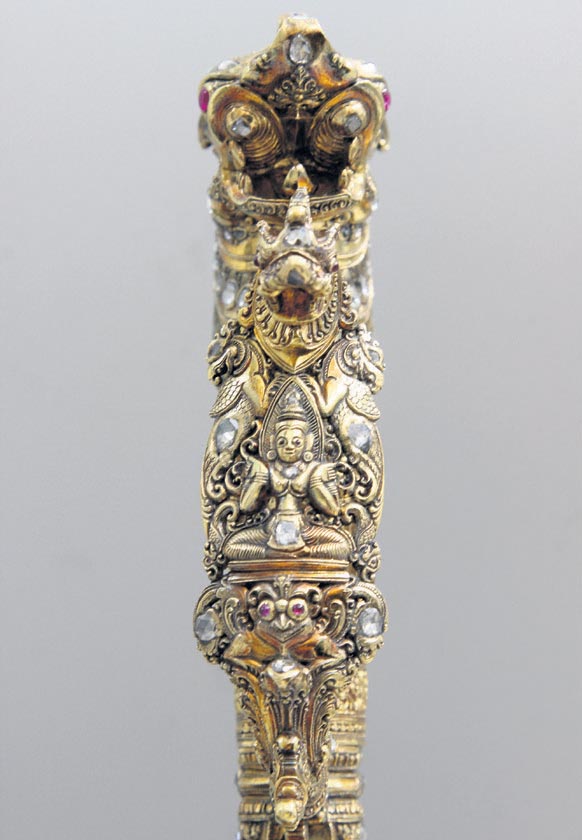Uncovering Layers and Crossing Borders: Provenance Research into Sri Lankan Objects from the Rijksmuseum
Among the 50 objects researched by the PPROCE research team, six were of Sri Lankan origin. These six objects are displayed in the Rijksmuseum: a richly decorated ceremonial cannon, two kasthāné, a dagger, and two large wall guns or Maha Thuwakku [Figs. 1-5]. At first sight, the provenance of these objects was clear. The object information at the Rijksmuseum already told us that that all six were part of the spoils of the Kandyan-Dutch war from 1762-66. However, in some cases, such as with the cannon, conflicting stories about provenance circulated. In other cases, such as with the Maha Thuwakku, there was actually no concrete information available that linked these objects to the war. Our task was to review the existing knowledge and to search for additional archival traces that would allow us to reconstruct the trail of these objects from the Kandyan Kingdom into the collection of the Dutch Stadholder (which later became the basis of the collection of the Rijksmuseum). However, we ended up disclosing the histories of these objects by doing much more than that.
Introduction
The Sri Lanka work-package of PPROCE revolved around six objects which were assumed to have been spoils of the Kandyan-Dutch war 1762-1766. One of these objects, the embellished ceremonial cannon, plays a pivotal role in current restitution debates and Dutch and Sri Lankan journalists and scholars have been critical about earlier collaborative research initiatives.1 The work-package was designed as a collaborative and interdisciplinary project, which meant that it reached beyond the narrow historical provenance question of when and how an object ended up in a certain collection. Such questions, after all, tend to gravitate towards archival research, and in this case towards Dutch-language documentation kept in the Netherlands, to which Sri Lankan colleagues had little access.

Fig. 1: Golden pihiya, or knife, NG-NM-7114 (Photo: Rijksmuseum), pre-1765.
In hindsight, this turned out to be a very important decision. Along the way, we realized that it was not only the archives but also the objects themselves that carried clues and traces of their historical journey. Piecing these clues together thus became a truly collective effort, where experts joined in from different corners of the world. The main collaborators from Sri Lanka were Prof. Asoka de Zoysa and Dr. Ganga Dissanayake from Kelaniya University and Senarath Wickramasinghe and Chamikara Pilapitiya on behalf of the Colombo National Museum. Meanwhile, Doreen van den Boogaart and I joined the team as historians on behalf of the NIOD. In the course of the project, more experts were involved to help us solve very specific questions, ranging from, for example, the dating of the cannon’s copper by Arie Pappot of the Rijksmuseum to the assessments of the mechanics of the Maha Thuwaku’s flint lock by Philip Tom [Fig.10]. The detailed reconstruction of the object histories and the conclusions regarding their provenance that we drew are available open access.2 In this contribution, however, we will discuss the broader relevance of this interdisciplinary and multilateral research.

Figs. 2-3: Two Maha Thuwakku or large wall guns, NG-NM-519 and 520 (Photo: Rijksmuseum), pre-1765.
A broader approach to the question of provenance, which includes a biographical approach to the object and gives space for reflection on the changing socio-political context in which the object acquired meaning, allows for a more inclusive academic approach. In practice, the research shows that this socio-political context is usually less straightforward than would appear at first sight. Thorough knowledge and consideration of regional historiographical debates is therefore vital. In the case of Sri Lanka, for example, various views of essentialised ethnic identity and cultural uniqueness play a major part in social and academic debates. Other scholars seek to place Sri Lankan history, and that of the kingdom of Kandy in particular, in a global history perspective. In the words of Gananath Obeyesekere: “The interplay between the local and the foreign is not simply a phenomenon of Nāyaka [Kandyan] rule but existed in different shapes and forms in Lankan history and, one might even add, in the history of other nations.” 3 At the same time, the Netherlands long held a rather nostalgic view of its own colonial past in Sri Lanka, a situation that is but slowly changing. 4 , see: N. Wickramasinghe, ‘Voorwoord’ in: Lodewijk Wagenaar, Kaneel en Olifanten. Sri Lanka en Nederland sinds 1600. (Nijmegen, 2016), p. 13.] In the course of the research into the Sri Lankan objects from the Rijksmuseum, it proved important to recognise these at times conflicting views and historiographical trends. Moreover, it is through object research that we are able to make our own contribution to these debates by emphasising the layered and borderless history of Sri Lanka in the 18th century.
Layered history
The provenance research into the Sri Lankan objects largely revolved around unravelling the layered and culturally intertwined histories of the objects. Precisely because of this layeredness of the objects, the research needed a transnational, borderless approach, in both the literal and the figurative sense. As an island in the middle of the Indian Ocean, Sri Lanka has a long history of external political, cultural, and economic influences. For example, in the 17th and 18th centuries, the Kingdom of Kandy maintained dynastic relations with courts in South India and had religious links with other centres of Theravada Buddhism in Arakan (Myanmar) and Ayutthaya (Thailand). Moreover, it is one of the few regions in the world scarred by colonialisation by three successive European powers: the Portuguese (1506-1658), the Dutch (1658-1796), and the British (1796-1947). The recent political history of Sri Lanka was long dominated by a nationalist discourse, in which foreign cultural influences were minimalised and the history of minorities was marginalised. In the words of Zoltán Biedermann and Alan Strathern, “here remains indeed a general sensitivity towards ‘foreign interference’ in the past and in the present, whether that is suspected as emanating from the neighbouring behemoth of India or the more distant ex-hegemon of Europe or ‘the West.’” 5

Fig. 5: Golden and Silver kasthāné, or sword, NG-NM-7112 and 560 (Photo: Rijksmuseum, pre-1765).
The six Sri Lankan objects from the Rijksmuseum bear traces of this layered history of Sri Lanka. On the one hand, they portray cultural processes of localisation, interconnectedness, and exchange. On the other hand, they show the raw history of physical appropriation of land, people, and resources by the VOC. The research into these objects was a fascinating process in which we sought to untangle the objects’ various layers. The provenance question with which we started the research automatically led to broader questions about the manufacturing history and signification.
Take, for example, the cannon of Kandy – or “Lewke’s cannon,” as it is called. The layered history was a part of the socio-political biography of this object, both literally and figuratively. For instance, the cannon turned out to have been decorated in various stages. Our research showed that it was probably originally cast in the Dutch Republic or Batavia as a gift from the VOC to or by order of the king of Kandy. That also explains why the cannon was originally decorated with acanthus leaves and cherubs – familiar European motifs. But it also bore a number of typically local elements, including a Kandyan crest decoration and a typical ‘oriental’ onion-shaped knob on the end, highly uncommon for cannons in Europe. So even this most basic layer of the cannon expresses a history of cultural adaptation and interconnectedness.
Subsequently the cannon was further embellished with exceptionally rich decoration, which appeared largely Kandyan in nature. It is also during this phase that a Sinhalese inscription was added. Dr. Ganga Dissanayake reinterpreted the inscription, which allowed us to conclude that the lavish decoration had been applied at the instruction of the Sinhalese noble Lewke Disawe (ca. 1680/90 – 1751), an important political figure in the 18th-century kingdom of Kandy. 6 Closer inspection of the motifs, conducted by Dr. Dissanayake and Prof. de Zoysa, once again revealed traces of cultural interconnectedness: the elegant narilathas (“plant women”) engraved on its side – most unusually – have wings which appear to echo the wings of the cherubs applied at an earlier date. Other elements, such as the engraved giant squirrel, a type of animal endemic to Sri Lanka and South India, conversely pointed to the specifically local context in which the decoration had been applied.
Socio-political biography of the objects
Right from the start, the cannon was a political object, having twice served to curry favour with the king of Kandy, first by the VOC and later by Lewke Disawe. The subsequent history of the cannon, however, reflects the violent context of colonialism: it was taken during the Dutch campaigns against the king of Kandy in 1762-1765 and subsequently gifted as spoils of war to Stadtholder William V (1748-1806), who displayed it in his cabinet of curiosities as a war trophy. In the 19th century, the object took on another new life when it was temporarily linked to national hero Michiel de Ruyter (1607-1676). In the 20th century, it was alternately interpreted both as a gift and as spoils of war. The trope that the cannon had been gift to the Dutch continued to haunt the cannon throughout the century and was used explicitly in the 1960s and 1970s by the ministry of culture as an argument against restitution. The PPROCE research, therefore, involved peeling away not only the art historical layers but also the various layers of meanings assigned to the cannon in the past.
Each object was found to have a different socio-political history. The manufacturing history of the Maha Thuwakku (large wall guns) brought to light an ancient history of technical knowledge exchange that led to the development of a sophisticated weapon industry in Kandy in the 17th and 18th centuries. Upon the request of Chamikara Pilapitiya, an expert on historical guns, these huge guns were dismantled in the studio of the Rijksmuseum, and together with experts, the mechanics were studied and disclosed [Fig. 6]. With clear traces of usage, these heavy weapons literally carry with them the history of the war between Kandy and the VOC in 1762-65.

Fig. 6: Inspecting the mechanics of the Maha Thuwakku in the studio of the Rijksmuseum (Photo by Eveline Sint Nicolaas, Rijksmuseum).
The golden kasthāné has a beautiful and typically Kandyan hilt of solid gold, inlaid with no fewer than 138 diamonds and 13 rubies. The shining gold, rubies, and diamonds immediately catch the eye. Once studied up close, this object, too, turned out to carry layers of local and global history: a closer analysis of one of the rubies revealed a possible provenance of this precious stone from Myanmar. The ruby probably found its way into Kandy through the kingdom’s longstanding diplomatic contact with Arakan. At the same time, this royal ceremonial weapon has a blade with a clear VOC origin, once again revealing the object’s entangled history.
At the centre of the densely decorated knuckle guard, Sri Lakshmi (the goddess of prosperity) is elegantly seated, while Saraswathi (the goddess of wisdom) adorns the inner part of the knuckle guard [Fig. 7]. During the research, Senarath Wickramasinghe from the Colombo National Museum pointed out that Sri Lakshmi and Saraswathi similarly adorn the Kandyan throne, which was made in the same period and is currently one of the centre pieces in the Colombo National Museum.
The biographies of these Sri Lankan objects thus make an extremely complex history tangible. It is the uncomfortable history of a world in which cultural transfer, diplomacy, and violent conflict were inextricably linked.

Fig. 7: Detail of the knuckle guard of the golden kasthāné, including goddess Lakshmi (Photo by Joosje van Bennekom, Rijksmuseum).
Crossing borders
Cross-disciplinary cooperation was essential in creating the object biographies. The collaboration with experts from Sri Lanka and other parts of the world was vital: expertise in the area of 18th-century Sri Lankan (Kandyan) art, crafts, weapons, and epigraphy is virtually non-existent in the Netherlands. Conversely, the language barrier means that Dutch archives are virtually inaccessible to most Sri Lankans, despite some of them being held in the National Archives of Sri Lanka in Colombo. The archival research into the VOC and Dutch Royal archives provided us, in some cases, with surprising detail on the provenance of the six objects. Through a careful reading of the palace descriptions in the embassy reports from the VOC archives, we were able to locate Lewke’s cannon, decorated and well, in front of the palace audience hall in 1749. We also managed to fully reconstruct the shipment of the cannon from Colombo to Amsterdam and find evidence of it being displayed explicitly as war trophy in the Dutch Stadholder's cabinet of curiosities in the 1770s. We could also reconstruct the journey that the Maha Thuwakku took via Batavia (Jakarta) to arrive in the collection of the Dutch Stadholder in 1769, together with two other large guns. In other cases, such as the golden kasthāné, the archives were less accommodating, and we were confronted with gaps in our knowledge.
Although physical border crossing was impossible for the duration of the project due to Covid-19, much could be achieved via video calls (e.g., close joint examination of detailed photographs of inscriptions and motifs on the objects and archive files). This provided an effective way for researchers who were looking at the objects from different disciplines to share their observations and analyses.
There is also another way in which the experience with Sri Lanka brought important insights. Sri Lanka is a country that, like many other parts of the world (e.g., Taiwan, Brazil, South Africa, Ghana) has a Dutch-colonial past that impacted the subsequent colonisation by other European – or, in the case of Taiwan, Asian – powers. People in the Netherlands were and are often not so aware of the frequently violent role played by the Dutch in this early history of colonisation. Until quite recently, this had consequences for how objects from these regions were treated: applications for restitution were not taken seriously, and painful histories of war and violence were often downplayed. This was not beneficial to the dialogue.
This blind spot that the Netherlands has with regard to its own colonial past also played a role in a different way. With the discussion about the objects being viewed as a purely Dutch-Sri Lankan matter, earlier reconstructions of the object histories rarely looked beyond these borders. As demonstrated by the aforementioned cannon of Kandy, however, it was important for the research to orient itself beyond the borders of the Netherlands and Sri Lanka. Thanks to the involvement of historical cannon specialists, Ruth Brown and Kay Smith, we were able to track down two similar cannons, which are held in Windsor Castle. A comparison of these three cannons produced important insights into the manufacturing history.
There was also another way in which the British legacy played a role in the history of the objects we researched: Sri Lankan interest in the cannon was sparked in the 1930s, when in 1934 a number of royal objects were returned by Great Britain to the national museum in Sri Lanka (then Ceylon). 7 These objects had been presented to the British royal house as spoils of war after the conquest of Kandy in 1815 After gaining its independence in 1947, Sri Lankan officials also made a number of applications to the Dutch Government and representatives for restitution of the cannon, but the Netherlands never took these requests seriously. Not only was Sri Lanka not on the radar; it is also likely that government officials in the Netherlands were unaware that the British had already restituted Kandyan objects and that this was deeply important to Sri Lanka. In other words, for the Netherlands, the cannon simply belonged to a history that it regarded as ‘closed.’ Yet this same history is still visible everywhere in Sri Lanka and, moreover, paved the way for British colonialism. From the Sri Lankan point of view, these histories are therefore inextricably linked. And what applies to Sri Lanka will also apply to many other areas upon which the Netherlands has left its colonial mark. 8
Alicia Schrikker is senior lecturer in colonial and global history at Leiden University. She currently leads two research projects funded by NWO: “Colonialism Inside Out: Everyday Experience and Plural Practice in Dutch Institutions in Sri Lanka (c.1700-1800),” and “Institutional Memory in the Making of Colonial Culture: History, Experience and Ideas in Dutch Colonialism in Asia, 1700-1870.” For PPROCE she coordinated the research that investigated the provenance of the Sri Lankan objects from the Rijksmuseum. E-mail: a.f.schrikker@hum.leidenuniv.nl